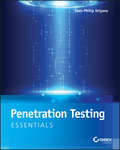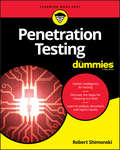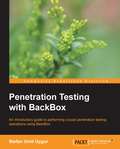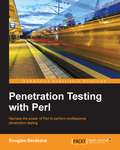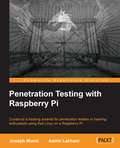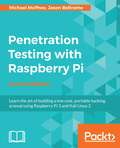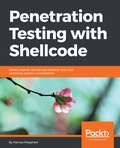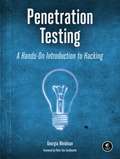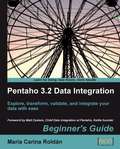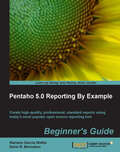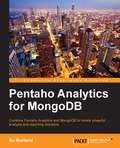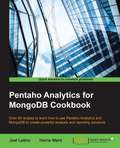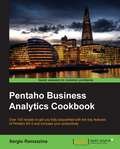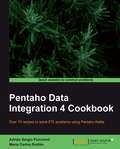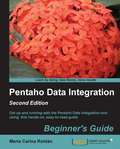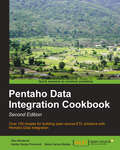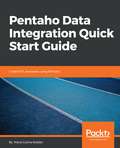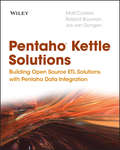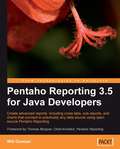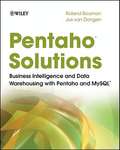- Table View
- List View
Penetration Testing Essentials
by Sean-Philip OriyanoYour pen testing career begins here, with a solid foundation in essential skills and concepts Penetration Testing Essentials provides a starting place for professionals and beginners looking to learn more about penetration testing for cybersecurity. Certification eligibility requires work experience—but before you get that experience, you need a basic understanding of the technical and behavioral ways attackers compromise security, and the tools and techniques you'll use to discover the weak spots before others do. You'll learn information gathering techniques, scanning and enumeration, how to target wireless networks, and much more as you build your pen tester skill set. You'll learn how to break in, look around, get out, and cover your tracks, all without ever being noticed. Pen testers are tremendously important to data security, so they need to be sharp and well-versed in technique, but they also need to work smarter than the average hacker. This book set you on the right path, with expert instruction from a veteran IT security expert with multiple security certifications. IT Security certifications have stringent requirements and demand a complex body of knowledge. This book lays the groundwork for any IT professional hoping to move into a cybersecurity career by developing a robust pen tester skill set. Learn the fundamentals of security and cryptography Master breaking, entering, and maintaining access to a system Escape and evade detection while covering your tracks Build your pen testing lab and the essential toolbox Start developing the tools and mindset you need to become experienced in pen testing today.
Penetration Testing For Dummies
by Robert ShimonskiTarget, test, analyze, and report on security vulnerabilities with pen testing Pen Testing is necessary for companies looking to target, test, analyze, and patch the security vulnerabilities from hackers attempting to break into and compromise their organizations data. It takes a person with hacking skills to look for the weaknesses that make an organization susceptible to hacking. Pen Testing For Dummies aims to equip IT enthusiasts at various levels with the basic knowledge of pen testing. It is the go-to book for those who have some IT experience but desire more knowledge of how to gather intelligence on a target, learn the steps for mapping out a test, and discover best practices for analyzing, solving, and reporting on vulnerabilities. The different phases of a pen test from pre-engagement to completion Threat modeling and understanding risk When to apply vulnerability management vs penetration testing Ways to keep your pen testing skills sharp, relevant, and at the top of the game Get ready to gather intelligence, discover the steps for mapping out tests, and analyze and report results!
Penetration Testing with BackBox
by Stefan Umit UygurThis practical book outlines the steps needed to perform penetration testing using BackBox. It explains common penetration testing scenarios and gives practical explanations applicable to a real-world setting. This book is written primarily for security experts and system administrators who have an intermediate Linux capability. However, because of the simplicity and user-friendly design, it is also suitable for beginners looking to understand the principle steps of penetration testing.
Penetration Testing with Perl
by Douglas BerdeauxIf you are an expert Perl programmer interested in penetration testing or information security, this guide is designed for you. However, it will also be helpful for you even if you have little or no Linux shell experience.
Penetration Testing with Raspberry Pi
by Joseph Muniz Aamir LakhaniIf you are looking for a low budget, small form-factor remotely accessible hacking tool, then the concepts in this book are ideal for you. If you are a penetration tester who wants to save on travel costs by placing a low-cost node on a target network, you will save thousands by using the methods covered in this book. You do not have to be a skilled hacker or programmer to use this book. It will be beneficial to have some networking experience; however, it is not required to follow the concepts covered in this book.
Penetration Testing with Raspberry Pi
by Joseph Muniz Aamir LakhaniIf you are looking for a low budget, small form-factor remotely accessible hacking tool, then the concepts in this book are ideal for you. If you are a penetration tester who wants to save on travel costs by placing a low-cost node on a target network, you will save thousands by using the methods covered in this book. You do not have to be a skilled hacker or programmer to use this book. It will be beneficial to have some networking experience; however, it is not required to follow the concepts covered in this book.
Penetration Testing with Raspberry Pi - Second Edition
by Jason Beltrame Michael McpheeLearn the art of building a low-cost, portable hacking arsenal using Raspberry Pi 3 and Kali Linux 2 About This Book * Quickly turn your Raspberry Pi 3 into a low-cost hacking tool using Kali Linux 2 * Protect your confidential data by deftly preventing various network security attacks * Use Raspberry Pi 3 as honeypots to warn you that hackers are on your wire Who This Book Is For If you are a computer enthusiast who wants to learn advanced hacking techniques using the Raspberry Pi 3 as your pentesting toolbox, then this book is for you. Prior knowledge of networking and Linux would be an advantage. What You Will Learn * Install and tune Kali Linux 2 on a Raspberry Pi 3 for hacking * Learn how to store and offload pentest data from the Raspberry Pi 3 * Plan and perform man-in-the-middle attacks and bypass advanced encryption techniques * Compromise systems using various exploits and tools using Kali Linux 2 * Bypass security defenses and remove data off a target network * Develop a command and control system to manage remotely placed Raspberry Pis * Turn a Raspberry Pi 3 into a honeypot to capture sensitive information In Detail This book will show you how to utilize the latest credit card sized Raspberry Pi 3 and create a portable, low-cost hacking tool using Kali Linux 2. You'll begin by installing and tuning Kali Linux 2 on Raspberry Pi 3 and then get started with penetration testing. You will be exposed to various network security scenarios such as wireless security, scanning network packets in order to detect any issues in the network, and capturing sensitive data. You will also learn how to plan and perform various attacks such as man-in-the-middle, password cracking, bypassing SSL encryption, compromising systems using various toolkits, and many more. Finally, you'll see how to bypass security defenses and avoid detection, turn your Pi 3 into a honeypot, and develop a command and control system to manage a remotely-placed Raspberry Pi 3. By the end of this book you will be able to turn Raspberry Pi 3 into a hacking arsenal to leverage the most popular open source toolkit, Kali Linux 2.0. Style and approach This concise and fast-paced guide will ensure you get hands-on with penetration testing right from the start. You will quickly install the powerful Kali Linux 2 on your Raspberry Pi 3 and then learn how to use and conduct fundamental penetration techniques and attacks.
Penetration Testing with Shellcode: Detect, Exploit, And Secure Network-level And Operating System Vulnerabilities
by Hamza MegahedSecurity has always been a major concern for your application, your system, or your environment. This book's main goal is to build your skills for low-level security exploits, finding vulnerabilities and covering loopholes with shellcode, assembly, and Metasploit.
Penetration Testing with Shellcode: Detect, exploit, and secure network-level and operating system vulnerabilities
by Hamza MegahedMaster Shellcode to leverage the buffer overflow concept Key Features Understand how systems can be bypassed both at the operating system and network level with shellcode, assembly, and Metasploit Learn to write and modify 64-bit shellcode along with kernel-level shellcode concepts A step-by-step guide that will take you from low-level security skills to covering loops with shellcode Book Description Security has always been a major concern for your application, your system, or your environment. This book's main goal is to build your skills for low-level security exploits, finding vulnerabilities and covering loopholes with shellcode, assembly, and Metasploit. This book will teach you topics ranging from memory management and assembly to compiling and extracting shellcode and using syscalls and dynamically locating functions in memory. This book also covers techniques to compile 64-bit shellcode for Linux and Windows along with Metasploit shellcode tools. Lastly, this book will also show you to how to write your own exploits with intermediate techniques, using real-world scenarios. By the end of this book, you will have become an expert in shellcode and will understand how systems are compromised both at the operating system and network level. What you will learn Create an isolated lab to test and inject shellcodes (Windows and Linux). Understand both Windows and Linux behavior. Learn the assembly programming language. Create shellcode using assembly and Metasploit. Detect buffer overflows. Debug and reverse-engineer using tools such as GDB, edb, and Immunity (Windows and Linux). Exploit development and shellcodes injections (Windows & Linux). Prevent and protect against buffer overflows and heap corruption. Who this book is for This book is intended to be read by penetration testers, malware analysts, security researchers, forensic practitioners, exploit developers, C language programmers, software testers, and students in the security field. Readers should have a basic understanding of OS internals (Windows and Linux). Some knowledge of the C programming language is essential, and a familiarity with the Python language would be helpful.
Penetration Testing with the Bash shell
by Keith MakanAn easy-to-understand, step-by-step practical guide that shows you how to use the Linux Bash terminal tools to solve information security problems. If you are a penetration tester, system administrator, or developer who would like an enriching and practical introduction to the Bash shell and Kali Linux command-line-based tools, this is the book for you.
Penetration Testing: A Hands-On Introduction to Hacking
by Georgia WeidmanPenetration testers simulate cyber attacks to find security weaknesses in networks, operating systems, and applications. Information security experts worldwide use penetration techniques to evaluate enterprise defenses.In Penetration Testing, security expert, researcher, and trainer Georgia Weidman introduces you to the core skills and techniques that every pentester needs. Using a virtual machine–based lab that includes Kali Linux and vulnerable operating systems, you’ll run through a series of practical lessons with tools like Wireshark, Nmap, and Burp Suite. As you follow along with the labs and launch attacks, you’ll experience the key stages of an actual assessment—including information gathering, finding exploitable vulnerabilities, gaining access to systems, post exploitation, and more.Learn how to:–Crack passwords and wireless network keys with brute-forcing and wordlists–Test web applications for vulnerabilities–Use the Metasploit Framework to launch exploits and write your own Metasploit modules–Automate social-engineering attacks–Bypass antivirus software–Turn access to one machine into total control of the enterprise in the post exploitation phaseYou’ll even explore writing your own exploits. Then it’s on to mobile hacking—Weidman’s particular area of research—with her tool, the Smartphone Pentest Framework.With its collection of hands-on lessons that cover key tools and strategies, Penetration Testing is the introduction that every aspiring hacker needs.
Penetration Testing: A Survival Guide
by Juned Ahmed Ansari Bo Weaver Wolf Halton Srinivasa Rao Kotipalli Mohammed A. ImranA complete pentesting guide facilitating smooth backtracking for working hackers About This Book • Conduct network testing, surveillance, pen testing and forensics on MS Windows using Kali Linux • Gain a deep understanding of the flaws in web applications and exploit them in a practical manner • Pentest Android apps and perform various attacks in the real world using real case studies Who This Book Is For This course is for anyone who wants to learn about security. Basic knowledge of Android programming would be a plus. What You Will Learn • Exploit several common Windows network vulnerabilities • Recover lost files, investigate successful hacks, and discover hidden data in innocent-looking files • Expose vulnerabilities present in web servers and their applications using server-side attacks • Use SQL and cross-site scripting (XSS) attacks • Check for XSS flaws using the burp suite proxy • Acquaint yourself with the fundamental building blocks of Android Apps in the right way • Take a look at how your personal data can be stolen by malicious attackers • See how developers make mistakes that allow attackers to steal data from phones In Detail The need for penetration testers has grown well over what the IT industry ever anticipated. Running just a vulnerability scanner is no longer an effective method to determine whether a business is truly secure. This learning path will help you develop the most effective penetration testing skills to protect your Windows, web applications, and Android devices. The first module focuses on the Windows platform, which is one of the most common OSes, and managing its security spawned the discipline of IT security. Kali Linux is the premier platform for testing and maintaining Windows security. Employs the most advanced tools and techniques to reproduce the methods used by sophisticated hackers. In this module first,you'll be introduced to Kali's top ten tools and other useful reporting tools. Then, you will find your way around your target network and determine known vulnerabilities so you can exploit a system remotely. You'll not only learn to penetrate in the machine, but will also learn to work with Windows privilege escalations. The second module will help you get to grips with the tools used in Kali Linux 2.0 that relate to web application hacking. You will get to know about scripting and input validation flaws, AJAX, and security issues related to AJAX. You will also use an automated technique called fuzzing so you can identify flaws in a web application. Finally, you'll understand the web application vulnerabilities and the ways they can be exploited. In the last module, you'll get started with Android security. Android, being the platform with the largest consumer base, is the obvious primary target for attackers. You'll begin this journey with the absolute basics and will then slowly gear up to the concepts of Android rooting, application security assessments, malware, infecting APK files, and fuzzing. You'll gain the skills necessary to perform Android application vulnerability assessments and to create an Android pentesting lab. This Learning Path is a blend of content from the following Packt products: • Kali Linux 2: Windows Penetration Testing by Wolf Halton and Bo Weaver • Web Penetration Testing with Kali Linux, Second Edition by Juned Ahmed Ansari • Hacking Android by Srinivasa Rao Kotipalli and Mohammed A. Imran Style and approach This course uses easy-to-understand yet professional language for explaining concepts to test your network's security.
Penetrationstests erfolgreich umsetzen: Praxisleitfaden - Regulatorik - KI-Einflüsse (KI – Best Practice in Industrie, Dienstleistung und Verwaltung)
by Stephen Fedtke Horst Speichert Bernhard C. Witt Nina WagnerDieses Buch ist ein Praxisleitfaden für Verantwortliche in Unternehmen, die Pentests erfolgreich umsetzen wollen. Dabei werden aktuelle regulatorische Anforderungen und Herausforderungen ebenso beleuchtet wie die unterstützende Wirkung der KI. Professionelle Dienstleister decken durch Pentests Schwachstellen in Komponenten auf, damit Betroffene diese proaktiv beheben können. Dabei werden Vorgehen und Methoden echter Angreifer angewendet. Die Autoren geben praxisnahe Tipps zum Vorgehen, beginnend bei der Planung erster Pentests bis zur Nachbereitung. Es wird in sämtlichen Phasen aufgezeigt, wie für alle Seiten ein optimaler Nutzen aus Pentest-Projekten gezogen wird, bei gleichzeitig rechtlich sicheren Rahmenbedingungen.
Pentaho 3.2 Data Integration: Beginner's Guide
by Maria Carina RoldanAs part of Packt's Beginner's Guide, this book focuses on teaching by example. The book walks you through every aspect of PDI, giving step-by-step instructions in a friendly style, allowing you to learn in front of your computer, playing with the tool. The extensive use of drawings and screenshots make the process of learning PDI easy. Throughout the book numerous tips and helpful hints are provided that you will not find anywhere else. The book provides short, practical examples and also builds from scratch a small datamart intended to reinforce the learned concepts and to teach you the basics of data warehousing. This book is for software developers, database administrators, IT students, and everyone involved or interested in developing ETL solutions, or, more generally, doing any kind of data manipulation. If you have never used PDI before, this will be a perfect book to start with. You will find this book is a good starting point if you are a database administrator, data warehouse designer, architect, or any person who is responsible for data warehouse projects and need to load data into them. You don't need to have any prior data warehouse or database experience to read this book. Fundamental database and data warehouse technical terms and concepts are explained in easy-to-understand language.
Pentaho 5.0 Reporting By Example Beginner's Guide
by Dario R. Bernabeu Mariano Garcia MattioWritten in a friendly, example driven Beginner’s Guide format, there are plenty of step-by-step instructions to get you started fast! Pentaho 5.0 By Example: Beginner's Guide is the ideal companion for a wide-variety of developers. Whether you are new to the world of Business Intelligence reporting, or an experienced BI analyst, this book will guide you through the creation of your first reports in Pentaho. We assume some knowledge of the SQL language and database systems.
Pentaho Analytics for MongoDB
by Bo BorlandThis is an easy-to-follow guide on the key integration points between Pentaho and MongoDB. This book employs a practical approach designed to have Pentaho configured to talk to MongoDB early on so that you see rapid results. This book is intended for business analysts, data architects, and developers new to either Pentaho or MongoDB who want to be able to deliver a complete solution for storing, processing, and visualizing data. It's assumed that you will already have experience defining data requirements needed to support business processes and exposure to database modeling, SQL query, and reporting techniques.
Pentaho Analytics for MongoDB Cookbook
by Harris Ward Joel LatinoOver 50 recipes to learn how to use Pentaho Analytics and MongoDB to create powerful analysis and reporting solutions About This Book * Create reports and stunning dashboards with MongoDB data * Accelerate data access and maximize productivity with unique features of Pentaho for MongoDB * A step-by-step recipe-based guide for making full use of Pentaho suite tools with MongoDB Who This Book Is For This book is intended for data architects and developers with a basic level of knowledge of MongoDB. Familiarity with Pentaho is not expected. What You Will Learn * Extract, load, and transform data from MongoDB collections to other datasources * Design Pentaho Reports using different types of connections for MongoDB * Create a OLAP mondrian schema for MongoDB * Explore your MongoDB data using Pentaho Analyzer * Utilize the drag and drop web interface to create dashboards * Use Kettle Thin JDBC with MongoDB for analysis * Integrate advanced dashboards with MondoDB using different types of connections * Publish and run a report on Pentaho BI server using a web interface In Detail MongoDB is an open source, schemaless NoSQL database system. Pentaho as a famous open source Analysis tool provides high performance, high availability, and easy scalability for large sets of data. The variant features in Pentaho for MongoDB are designed to empower organizations to be more agile and scalable and also enables applications to have better flexibility, faster performance, and lower costs. Whether you are brand new to online learning or a seasoned expert, this book will provide you with the skills you need to create turnkey analytic solutions that deliver insight and drive value for your organization. The book will begin by taking you through Pentaho Data Integration and how it works with MongoDB. You will then be taken through the Kettle Thin JDBC Driver for enabling a Java application to interact with a database. This will be followed by exploration of a MongoDB collection using Pentaho Instant view and creating reports with MongoDB as a datasource using Pentaho Report Designer. The book will then teach you how to explore and visualize your data in Pentaho BI Server using Pentaho Analyzer. You will then learn how to create advanced dashboards with your data. The book concludes by highlighting contributions of the Pentaho Community. Style and approach A comprehensive, recipe-based guide to take complete advantage of the Pentaho Analytics for MongoDB.
Pentaho Business Analytics Cookbook
by Sergio RamazzinaThis practical guide contains a wide variety of recipes, taking you through all the topics you need to quickly familiarize yourself with Pentaho and extend your Pentaho skillset. If you are involved in daily activities using Pentaho Business Analytics platform, this is the book for you. It is a good companion to get you quickly acquainted with everything you need to increase your productivity with the platform. We assume basic familiarity with Pentaho, data warehouse design and SQL, HTML, and XML.
Pentaho Data Integration 4 Cookbook
by Adrian Sergio PulvirentiThis book has step-by-step instructions to solve data manipulation problems using PDI in the form of recipes. It has plenty of well-organized tips, screenshots, tables, and examples to aid quick and easy understanding.If you are a software developer or anyone involved or interested in developing ETL solutions, or in general, doing any kind of data manipulation, this book is for you. It does not cover PDI basics, SQL basics, or database concepts. You are expected to have a basic understanding of the PDI tool, SQL language, and databases.
Pentaho Data Integration Beginner's Guide, Second Edition
by María Carina RoldanThis book focuses on teaching you by example. The book walks you through every aspect of Pentaho Data Integration, giving systematic instructions in a friendly style, allowing you to learn in front of your computer, playing with the tool. The extensive use of drawings and screenshots make the process of learning Pentaho Data Integration easy. Throughout the book, numerous tips and helpful hints are provided that you will not find anywhere else.This book is a must-have for software developers, database administrators, IT students, and everyone involved or interested in developing ETL solutions, or, more generally, doing any kind of data manipulation. Those who have never used Pentaho Data Integration will benefit most from the book, but those who have, they will also find it useful.This book is also a good starting point for database administrators, data warehouse designers, architects, or anyone who is responsible for data warehouse projects and needs to load data into them.
Pentaho Data Integration Cookbook Second Edition
by Alex ArbucklePentaho Data Integration Cookbook Second Edition is written in a cookbook format, presenting examples in the style of recipes.This allows you to go directly to your topic of interest, or follow topics throughout a chapter to gain a thorough in-depth knowledge.Pentaho Data Integration Cookbook Second Edition is designed for developers who are familiar with the basics of Kettle but who wish to move up to the next level.It is also aimed at advanced users that want to learn how to use the new features of PDI as well as and best practices for working with Kettle.
Pentaho Data Integration Quick Start Guide: Create ETL processes using Pentaho
by María Carina RoldánGet productive quickly with Pentaho Data IntegrationKey FeaturesTake away the pain of starting with a complex and powerful systemSimplify your data transformation and integration workExplore, transform, and validate your data with Pentaho Data IntegrationBook DescriptionPentaho Data Integration(PDI) is an intuitive and graphical environment packed with drag and drop design and powerful Extract-Transform-Load (ETL) capabilities. Given its power and flexibility, initial attempts to use the Pentaho Data Integration tool can be difficult or confusing. This book is the ideal solution.This book reduces your learning curve with PDI. It provides the guidance needed to make you productive, covering the main features of Pentaho Data Integration. It demonstrates the interactive features of the graphical designer, and takes you through the main ETL capabilities that the tool offers.By the end of the book, you will be able to use PDI for extracting, transforming, and loading the types of data you encounter on a daily basis.What you will learnDesign, preview and run transformations in SpoonRun transformations using the Pan utilityUnderstand how to obtain data from different types of files Connect to a database and explore it using the database explorerUnderstand how to transform data in a variety of waysUnderstand how to insert data into database tablesDesign and run jobs for sequencing tasks and sending emailsCombine the execution of jobs and transformationsWho this book is forThis book is for software developers, business intelligence analysts, and others involved or interested in developing ETL solutions, or more generally, doing any kind of data manipulation.
Pentaho Kettle Solutions
by Jos Van Dongen Matt Casters Roland BoumanA complete guide to Pentaho Kettle, the Pentaho Data lntegration toolset for ETLThis practical book is a complete guide to installing, configuring, and managing Pentaho Kettle. If you're a database administrator or developer, you'll first get up to speed on Kettle basics and how to apply Kettle to create ETL solutions--before progressing to specialized concepts such as clustering, extensibility, and data vault models. Learn how to design and build every phase of an ETL solution.Shows developers and database administrators how to use the open-source Pentaho Kettle for enterprise-level ETL processes (Extracting, Transforming, and Loading data)Assumes no prior knowledge of Kettle or ETL, and brings beginners thoroughly up to speed at their own paceExplains how to get Kettle solutions up and running, then follows the 34 ETL subsystems model, as created by the Kimball Group, to explore the entire ETL lifecycle, including all aspects of data warehousing with KettleGoes beyond routine tasks to explore how to extend Kettle and scale Kettle solutions using a distributed "cloud"Get the most out of Pentaho Kettle and your data warehousing with this detailed guide--from simple single table data migration to complex multisystem clustered data integration tasks.
Pentaho Reporting 3.5 for Java Developers
by Will GormanThis hands-on tutorial, filled with exercises and examples, introduces the reader to a variety of concepts within Pentaho Reporting. With screenshots that show you how reports look at design time as well as how they should look when rendered as PDF, Excel, or HTML, this book also contains complete example source code that you can copy and paste into your environment to get up and running quickly. This book is primarily written for Java developers who want to assemble custom reporting solutions with Pentaho Reporting. Their main interest is in the technical details of creating reports and they want to see how to solve common report problems with a minimum of fuss; they do not need an overview of BI or the importance of reporting. Secondary audiences of this book are IT professionals who need to install a reporting solution in their environment, and want to learn advanced concepts within Pentaho Reporting such as sub-reports, cross-tabs, data source configuration, and metadata-based reporting.
Pentaho Solutions
by Jos Van Dongen Ronald BoumanYour all-in-one resource for using Pentaho with MySQL for Business Intelligence and Data Warehousing Open-source Pentaho provides business intelligence (BI) and data warehousing solutions at a fraction of the cost of proprietary solutions. Now you can take advantage of Pentaho for your business needs with this practical guide written by two major participants in the Pentaho community. The book covers all components of the Pentaho BI Suite. You'll learn to install, use, and maintain Pentaho-and find plenty of background discussion that will bring you thoroughly up to speed on BI and Pentaho concepts. Of all available open source BI products, Pentaho offers the most comprehensive toolset and is the fastest growing open source product suite Explains how to build and load a data warehouse with Pentaho Kettle for data integration/ETL, manually create JFree (pentaho reporting services) reports using direct SQL queries, and create Mondrian (Pentaho analysis services) cubes and attach them to a JPivot cube browser Review deploying reports, cubes and metadata to the Pentaho platform in order to distribute BI solutions to end-users Shows how to set up scheduling, subscription and automatic distribution The companion Web site provides complete source code examples, sample data, and links to related resources.
